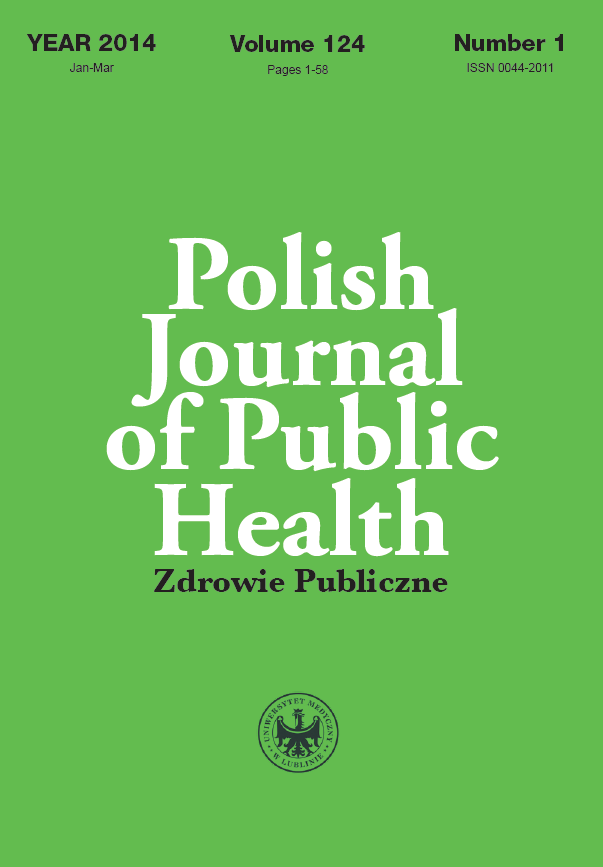The structure of dental procedures under general anaesthesia in children and adolescents with epilepsy
DOI:
https://doi.org/10.2478/pjph-2014-0006Słowa kluczowe:
epilepsy, children, adolescents, dental treatment, general anaesthesiaAbstrakt
Introduction. One of the indications for dental treatment in general anaesthesia of children and adolescents is the patients’ refusal to cooperate with the dentist; this concerns especially the so-called special care patients, and among them, those suffering from epilepsy.
Aim. The aim of the study was to evaluate the structure of treatment procedures in conservative dentistry and dental surgery performed under general anaesthesia in children and adolescents with epilepsy.
Material and methods. The analysis covered case histories of 109 patients with epilepsy, aged 3-18 years, who received dental treatment under general anaesthesia. The patients were divided into three age groups, according to the dentition type: patients with deciduous dentition – 3-5 years of age; with mixed dentition – 6-12 years, and with permanent dentition – 13-18 years. The analysis concerned the procedures on both deciduous and permanent teeth.
Results. An average number of extractions in a child with full deciduous dentition was 3.9 teeth, while in a child with mixed dentition – 2.7 teeth. The greatest number of deciduous teeth extractions concerned first and second molars. Carious cavities in the occlusal surfaces of permanent teeth, due to deep caries, were the most frequently treated lesions.
Conclusions. In patients with epilepsy treated under general anaesthesia, extensive treatment needs, resulting from prophylactic and therapeutic neglect in dental care, were found. Conservative and surgical treatment, combined with prophylactic procedures, performed under general anaesthesia seems one of the necessary elements of a complex dental care in uncooperative children and adolescents.
Bibliografia
1. Shneker BF, Fountain MB. Epilepsy. Dis Mon. 2003;49(7):426-78.
2. Mielnik-Błaszczak M, Skawińska A, Janus M, et al. Ocena stanu higieny jamy ustnej w grupie lubelskich dzieci chorych na padaczkę. Dent Med. Probl. 2009;46(2):234-8.
3. Skawińska A, Mielnik-Błaszczak M. Analiza stanu higieny jamy ustnej i periodontologicznych potrzeb leczniczych u dzieci i młodzieży chorych na padaczkę oraz padaczkę ze współwystępującą niepełnosprawnością umysłową. Stand Med Pediatr. 2011;8(3):488-92.
4. Limanowska-Shaw H, Paszyńska E, Deręgowska-Nosewicz P, et al. Ocena stanu dziąseł oraz nawyków higienicznych u sportowców olimpiad specjalnych. Czas Stomatol. 2003;56(6):415-20.
5. Szyperska AM, Janas A, Cyl M, Grzesiak-Janas G. Pacjenci z epilepsją w gabinecie stomatologicznym. Porad Stomatol. 2010;10(9):308-10.
6. Olszanecka M, Chmielnik J. Postępowanie w gabinecie stomatologicznym z dziećmi dotkniętymi padaczką i ADHD. Twój Przegl Stomatol. 2011;(5):62-4.
7. Bladowski M, Iwanowska-Sosnowska M, Nischk M. Stomatologia zachowawcza w znieczuleniu ogólnym. Tryb ambulatoryjny. Interpretacja i propozycja nowych przepisów dotyczących przeprowadzania zabiegów z zakresu stomatologii klinicznej w znieczuleniu ogólnym. Nowa Stomatol. 2001;1:37-45.
8. Szymańska J, Bogucka-Gordziejko M. Zabiegi stomatologiczne wykonywane w znieczuleniu ogólnym u pacjentów w wieku rozwojowym. Czas Stomatol. 1999;52(9):591-6.
9. Borysewicz-Lewicka M, Gerreth K, Wiśniewska K, Wysocki J. Leczenie stomatologiczne jako część wymaganej opieki medycznej nad dziećmi niepełnosprawnymi – opinia rodziców. Dent Med Probl. 2011;48(1):45-53.
10. Postek-Stefańska L, Ziętek P. Stan narządu żucia i problemy związane z leczeniem stomatologicznym dzieci chorujących na padaczkę. Przegląd piśmiennictwa. Mag Stomatol. 2005;15(11):10-3.
11. Brodie MJ, Frencz JA. Management of epilepsy in adolescents and adults. Lancet. 2000;356:323-9.
12. Michałowski A, Mielnik-Błaszczak M, Skawińska A, et al. Zabiegi stomatologiczne w znieczuleniu ogólnym w materiale Katedry i Zakładu Stomatologii Wieku Rozwojowego UM w Lublinie – obserwacja roczna. Mag Stomatol. 2009;19(9):70-2.


